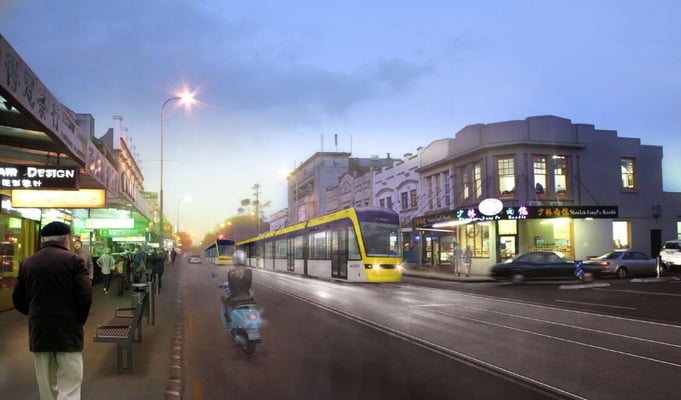'Politics of light rail': What should Aucklanders expect?

To what extent the Labour Party’s proposal to bring forward the light rail project immediately, if elected to power, will solve Auckland’s traffic congestion problems remain to be seen in the future. However, the announcement and National’s subsequent rebuttal of this proposal attributing it as an “election-bribe” for Mt Roskill by-election scheduled later this year has brought to fore another concern for Aucklanders—the “government-council clash” in planning the city’s transport woes.
Auckland accounts for 34% of New Zealand‘s population and generates 35% of GDP. Therefore, the performance of Auckland’s transport network has implications for the whole economy. Auckland is expected to grow by around 700,000 people or more than half of New Zealand’s total expected population growth over the next 30 years, and the question of government-council alignment in the long-term planning of Auckland’s future has always been a concern for the city’s residents.
It was only recently that an agreement between Auckland Council (outgoing) and central government had been struck, supposedly to end our biggest city's gridlock woes.
Transport Minister Simon Bridges and outgoing Auckland Mayor Len Brown had signed the Auckland Transport Alignment Project (ATAP) report on September 15 this year.
Bridges had then said that “it is essential that the government and Auckland Council are on the same page when it comes to how we can best plan for and meet the growing transport demand that flows directly from population growth. This is why we decided to set up the ATAP”.
Brown, expressing the will of the then Auckland Council, had replied: “ATAP is a major step forward. Through ATAP, we have agreed Auckland’s transport priorities and a 30-year investment prioritisation programme. Now we need a sustainable funding track.”
The expectations from that report, apart from finding ways of efficient funding for Auckland transport, was also to underline the importance of the convergence of local and central government over the long-term planning of the future transport system of Auckland.
That “alignment” seems to be in jeopardy with the recent Labour Party announcement of bringing forward the light rail project mentioned in this report immediately, if elected to power next year.
It is an irony that the very report that was supposed to “align” the local and central government towards Auckland’s future has given the ammunition for potentially jeopardising the much-needed alignment for planning Auckland's development
Phil Goff's election as the Mayor of Auckland was always going to be a potential source of a disjoint on the mandate of the report, given his vocal advocacy for bringing forward the light rail project during his pre-election speeches—a project that was not scheduled before 2028–2038.
But it was for Labour leader Andrew Little to take a lead and make an announcement on Sunday, October 30 “...to plan to bring forward the $1.3 billion light rail project linking Wynyard Quarter to Britomart, up Queen Street and along Dominion Road to Mt Roskill,” if elected to power next year.
Probably this way, Auckland's mayor is saved from being seen as someone breaking the alignment between the council and the central government. Plus, the Labour Party had an opportunity to take a lead on the issue of traffic congestion so dear to the Aucklanders.
Expectedly, the National Party has rejected the claim that light rail would be an effective solution to Auckland’s transport worries and affirmed that an improved “bus network” could be a better option to solve Dominion Road's traffic congestion.
The Nationals have scorned this announcement as an “election bribe”—an allegation that the Labours refute assertively.
In a media statement, National Party Campaign Chair Steven Joyce said, “Labour is hitting the panic button fairly early on.”
He further asserted, “Promising a $1.4 billion rail link between the electorate and the city looks very desperate.”
The Labour leader has rejected the allegation, stating that it is about bringing forward a plan that already exists.
Regardless of the “politics” so evidently visible, what is apparent is that the alignment between the council and the government will be under pressure after this recent announcement from the Labour Party.
Goff ostensibly appears to have developed cold feet from sharing the bill of the proposed project as suggested by Little.
Instead, he is of the opinion that this project “... [could be]... treated as a road of national significance and be fully funded by central government”.
Nationals already categorise the light rail project as "cost overblown" and a project that "needs to be developed further”, apparently giving a clear indication that a council-government discord is on cards regardless of who comes to power in 2017—a situation not many Aucklanders will be delighted with.
The fact that the ATAP report itself was an outcome of a couple of years of study on possible solutions to Auckland's traffic congestion in near future and there is no unanimity on the best way to address what many conceive as Auckland's major problem, is a disappointing outcome.
Ideally, Aucklanders want to see more action than deliberations of new ideas about how best to address traffic congestion on their roads. If Labour Party is guilty of throwing a new idea or “bringing forward” an idea of a project that is already agreed, allegedly on the pretext of Mt Roskill by election, then National Party is also equally guilty of condemning the project out rightly on the basis of some cost-overblown parallels from other OECD countries. The cost escalation of such major public projects is often more a reflection of administrative and financial mismanagement than a question mark on the efficacy of the project itself. Auckland’s road congestion problem requires more ingenuity than currently displayed by our political leadership.
Is light rail for Mt Roskill or CBD?
The way Labour Party has set the public debate and the way National party has responded to that debate, it appears that the Auckland’s proposed light rail is being seen as an exclusive solution to traffic congestion in the Mt Roskill suburb of greater Auckland instead of the larger CBD area.
Labour’s Mt Roskill candidate Michael Wood is calling on National’s candidate Dr Parmjeet Parmar to come clean on whether she supports Labour’s plan for light rail on the Auckland isthmus.
“I’m calling on her to put party politics to one side and support this plan to help fix the traffic in Roskill,” said Wood in a media statement.
Parmar is relying on Wood’s earlier comments from last year that “it’s not a fully formed proposal” and “we still don’t have clear information about funding,” to rebut the charge.
She further accentuates that the light rail is worth considering, but it is such a long-term proposal that it will do nothing to fix the transport problems Mt Roskill faces right now.
Clearly, the emphasis is that the light rail project is designed and meant to resolve Mt Roskill’s traffic congestion.
Originally, the light rail network was proposed as a solution to growing traffic pressure on the CBD and arterial roads leading to the CBD, of which Dominion Road is just one part. The other important routes under possible consideration of this project are Queen Street, Symonds Street, Sandringham Road, Manukau Road, and Mt Eden Road.
There is nothing wrong per se in projecting a demand for a suburb that will eventually serve all Aucklanders, however, the light rail project is not an ordinary suburb-related demand.
It is a complex project related to congestion in Auckland CBD, which requires a coordinated effort across multiple agencies, including New Zealand’s central government and New Zealand’s largest council government.
The positioning of this project as a solution to a specific suburb’s problem is undermining the targeted government-council alignment in the Auckland Transport Alignment Project (ATAP).
Is it a signal to common Aucklanders that they could expect a further delay in coordinated actions towards resolving one of their city’s major problems?
To what extent the Labour Party’s proposal to bring forward the light rail project immediately, if elected to power, will solve Auckland’s traffic congestion problems remain to be seen in the future. However, the announcement and National’s subsequent rebuttal of this proposal attributing it as an...
To what extent the Labour Party’s proposal to bring forward the light rail project immediately, if elected to power, will solve Auckland’s traffic congestion problems remain to be seen in the future. However, the announcement and National’s subsequent rebuttal of this proposal attributing it as an “election-bribe” for Mt Roskill by-election scheduled later this year has brought to fore another concern for Aucklanders—the “government-council clash” in planning the city’s transport woes.
Auckland accounts for 34% of New Zealand‘s population and generates 35% of GDP. Therefore, the performance of Auckland’s transport network has implications for the whole economy. Auckland is expected to grow by around 700,000 people or more than half of New Zealand’s total expected population growth over the next 30 years, and the question of government-council alignment in the long-term planning of Auckland’s future has always been a concern for the city’s residents.
It was only recently that an agreement between Auckland Council (outgoing) and central government had been struck, supposedly to end our biggest city's gridlock woes.
Transport Minister Simon Bridges and outgoing Auckland Mayor Len Brown had signed the Auckland Transport Alignment Project (ATAP) report on September 15 this year.
Bridges had then said that “it is essential that the government and Auckland Council are on the same page when it comes to how we can best plan for and meet the growing transport demand that flows directly from population growth. This is why we decided to set up the ATAP”.
Brown, expressing the will of the then Auckland Council, had replied: “ATAP is a major step forward. Through ATAP, we have agreed Auckland’s transport priorities and a 30-year investment prioritisation programme. Now we need a sustainable funding track.”
The expectations from that report, apart from finding ways of efficient funding for Auckland transport, was also to underline the importance of the convergence of local and central government over the long-term planning of the future transport system of Auckland.
That “alignment” seems to be in jeopardy with the recent Labour Party announcement of bringing forward the light rail project mentioned in this report immediately, if elected to power next year.
It is an irony that the very report that was supposed to “align” the local and central government towards Auckland’s future has given the ammunition for potentially jeopardising the much-needed alignment for planning Auckland's development
Phil Goff's election as the Mayor of Auckland was always going to be a potential source of a disjoint on the mandate of the report, given his vocal advocacy for bringing forward the light rail project during his pre-election speeches—a project that was not scheduled before 2028–2038.
But it was for Labour leader Andrew Little to take a lead and make an announcement on Sunday, October 30 “...to plan to bring forward the $1.3 billion light rail project linking Wynyard Quarter to Britomart, up Queen Street and along Dominion Road to Mt Roskill,” if elected to power next year.
Probably this way, Auckland's mayor is saved from being seen as someone breaking the alignment between the council and the central government. Plus, the Labour Party had an opportunity to take a lead on the issue of traffic congestion so dear to the Aucklanders.
Expectedly, the National Party has rejected the claim that light rail would be an effective solution to Auckland’s transport worries and affirmed that an improved “bus network” could be a better option to solve Dominion Road's traffic congestion.
The Nationals have scorned this announcement as an “election bribe”—an allegation that the Labours refute assertively.
In a media statement, National Party Campaign Chair Steven Joyce said, “Labour is hitting the panic button fairly early on.”
He further asserted, “Promising a $1.4 billion rail link between the electorate and the city looks very desperate.”
The Labour leader has rejected the allegation, stating that it is about bringing forward a plan that already exists.
Regardless of the “politics” so evidently visible, what is apparent is that the alignment between the council and the government will be under pressure after this recent announcement from the Labour Party.
Goff ostensibly appears to have developed cold feet from sharing the bill of the proposed project as suggested by Little.
Instead, he is of the opinion that this project “... [could be]... treated as a road of national significance and be fully funded by central government”.
Nationals already categorise the light rail project as "cost overblown" and a project that "needs to be developed further”, apparently giving a clear indication that a council-government discord is on cards regardless of who comes to power in 2017—a situation not many Aucklanders will be delighted with.
The fact that the ATAP report itself was an outcome of a couple of years of study on possible solutions to Auckland's traffic congestion in near future and there is no unanimity on the best way to address what many conceive as Auckland's major problem, is a disappointing outcome.
Ideally, Aucklanders want to see more action than deliberations of new ideas about how best to address traffic congestion on their roads. If Labour Party is guilty of throwing a new idea or “bringing forward” an idea of a project that is already agreed, allegedly on the pretext of Mt Roskill by election, then National Party is also equally guilty of condemning the project out rightly on the basis of some cost-overblown parallels from other OECD countries. The cost escalation of such major public projects is often more a reflection of administrative and financial mismanagement than a question mark on the efficacy of the project itself. Auckland’s road congestion problem requires more ingenuity than currently displayed by our political leadership.
Is light rail for Mt Roskill or CBD?
The way Labour Party has set the public debate and the way National party has responded to that debate, it appears that the Auckland’s proposed light rail is being seen as an exclusive solution to traffic congestion in the Mt Roskill suburb of greater Auckland instead of the larger CBD area.
Labour’s Mt Roskill candidate Michael Wood is calling on National’s candidate Dr Parmjeet Parmar to come clean on whether she supports Labour’s plan for light rail on the Auckland isthmus.
“I’m calling on her to put party politics to one side and support this plan to help fix the traffic in Roskill,” said Wood in a media statement.
Parmar is relying on Wood’s earlier comments from last year that “it’s not a fully formed proposal” and “we still don’t have clear information about funding,” to rebut the charge.
She further accentuates that the light rail is worth considering, but it is such a long-term proposal that it will do nothing to fix the transport problems Mt Roskill faces right now.
Clearly, the emphasis is that the light rail project is designed and meant to resolve Mt Roskill’s traffic congestion.
Originally, the light rail network was proposed as a solution to growing traffic pressure on the CBD and arterial roads leading to the CBD, of which Dominion Road is just one part. The other important routes under possible consideration of this project are Queen Street, Symonds Street, Sandringham Road, Manukau Road, and Mt Eden Road.
There is nothing wrong per se in projecting a demand for a suburb that will eventually serve all Aucklanders, however, the light rail project is not an ordinary suburb-related demand.
It is a complex project related to congestion in Auckland CBD, which requires a coordinated effort across multiple agencies, including New Zealand’s central government and New Zealand’s largest council government.
The positioning of this project as a solution to a specific suburb’s problem is undermining the targeted government-council alignment in the Auckland Transport Alignment Project (ATAP).
Is it a signal to common Aucklanders that they could expect a further delay in coordinated actions towards resolving one of their city’s major problems?









Leave a Comment